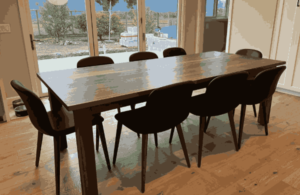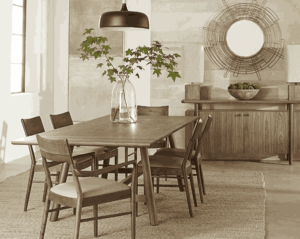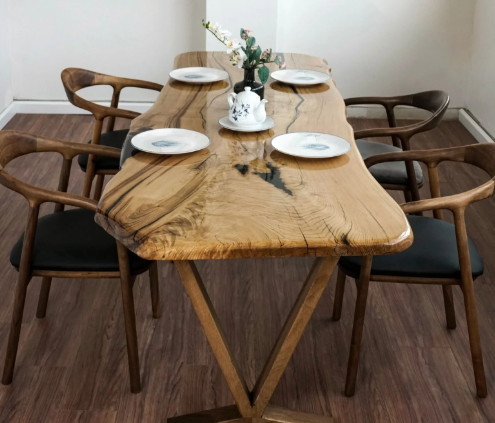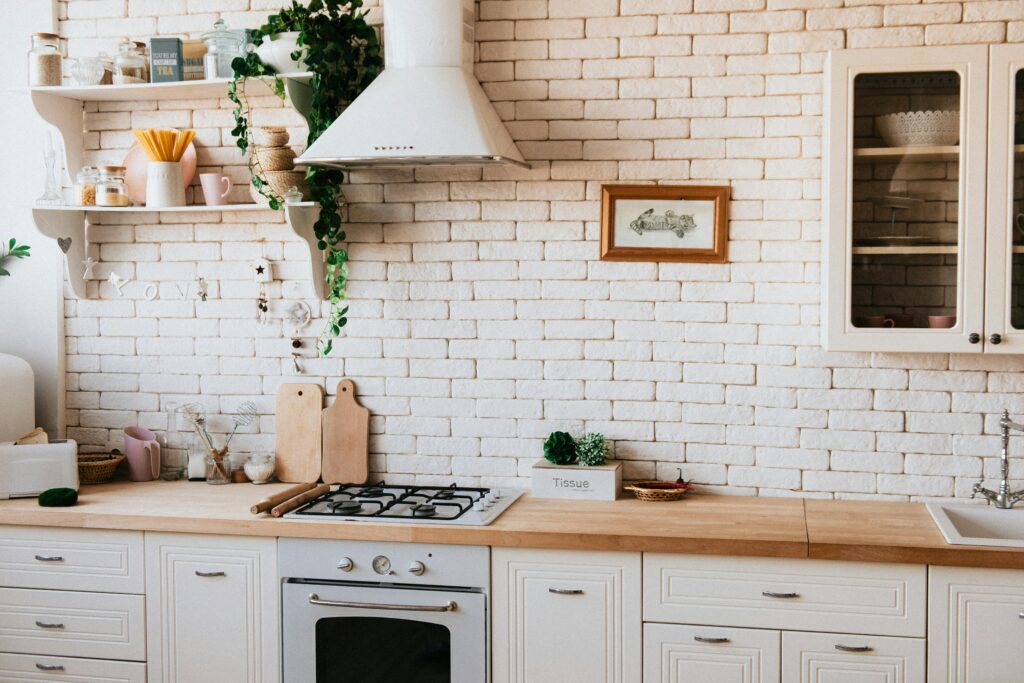Walnut Dining Room Table: The Perfect Centerpiece for Your Home
When selecting a dining table, solid wood options are timeless and durable. A walnut dining room table stands out for its rich tones, unique grain patterns, and lasting quality. In this guide, we explore various aspects of walnut dining tables, focusing on their styles, features, and the best practices for incorporating them into your dining space.
Walnut Dining Table Styles and Appeal
A walnut dining table offers versatility in design, seamlessly blending with both modern and classic interiors. Its natural wood color, often featuring rich brown hues and lighter streaks, complements various dining room aesthetics. The characteristics of walnut make it a popular choice for homeowners who value elegance and functionality of table shelves
Styles of Walnut Dining Tables
Turned Leg Tables: Classic designs like Modern Farm, Parson, and Cottage styles.
Pedestal Tables: Options such as the Carlisle, Newport, and Alexandria bases.
Live Edge Tables: Unique, rustic slabs with natural edges for a bold statement.
Round Walnut Tables: Perfect for small spaces or intimate settings

Turned Leg Walnut Tables
For a touch of traditional charm, consider a Modern Farm Leg Table. This design showcases real walnut wood with a turned leg style that adds character. Other styles like the Parson Leg Table or Cottage style tables offer a classic appeal while maintaining durability. The turned leg profiles emphasize the elegance of the walnut grain, making them ideal for a cozy dining space.
Pedestal Tables in Walnut
If you prefer a timeless design, explore pedestal table options like the Carlisle dining table. These tables highlight the beauty of walnut wood while offering practicality. The addition of Curlew side chairs or a matching bench enhances the ensemble. For smaller spaces, the Newport pedestal table, available in standard height or as a pub table, brings sophistication without overwhelming the room.
Choosing the Right Table Size
A common question is whether a 60-inch rectangle dining table is the best size for six chairs. While it’s a popular choice, a 66-inch table often accommodates chairs more comfortably. For those who entertain occasionally, a table with leaves to extend the seating capacity is a practical solution. Whether you prefer a fixed tabletop or an expandable option, walnut provides both beauty and utility.
Key Features of Walnut Dining Room Tables
- – Rich brown tones with lighter streaks for a unique aesthetic.
- – Durable hardwood with a Janka hardness rating of 1010.
- – Available in modern, traditional, and live edge styles.
- – Protected with catalyzed conversion varnish for resistance to scratches, water, and UV light.
Benefits of Walnut Tables
- – Complements modern and classic interiors.
- – Versatile size options, including 60-inch and 66-inch rectangle tables.
- – Flexible features like extendable leaves for additional seating.
- – Suitable for pairing with various chair styles, including Maple wood frames with walnut seats.
Round Walnut Dining Tables
For a more intimate setting, a round walnut table is an excellent option. These tables bring a luxurious tone to any dining area. Consider an extendable Albany dining table for larger gatherings, seating up to ten people. Smaller options like the Newport table feature a white painted Maple wood base paired with a walnut top, creating a stunning contrast.
Select Walnut: Which is Right for You?
Understanding the difference between rustic and select grade walnut wood is crucial when choosing a table. Rustic walnut often features sap streaks and color variation, showcasing the natural texture of the wood. This option is perfect for those who appreciate a more organic, textured look. On the other hand, select walnut offers a more uniform grain and minimal variation, making it ideal for modern minimalist designs.
Pairing Chairs with a Walnut Table
Selecting the right chair style can enhance the overall aesthetic of your table. While walnut wood chairs create a cohesive look, they can be pricey. A budget-friendly alternative is using Maple wood frames with walnut chair seats. This combination provides durability while maintaining a seamless match with the tabletop. Adding black or white accents further elevates the design.
Caring for Your Walnut Table
– Clean with mild soap and a soft cloth to maintain the finish.
– Avoid placing rough items like cardboard boxes to prevent scratches.
– Protect from prolonged direct sunlight to minimize color changes over time.

Protective Finish and Maintenance
To ensure longevity, walnut dining tables are often coated with a catalyzed conversion varnish. This protective finish is waterproof, UV resistant, and can withstand temperatures up to 220 degrees. Regular care involves using mild soap like Murphy’s Oil Soap or Dawn Dish soap diluted in warm water. Avoid placing rough plates, bowls, or cardboard boxes on the surface to prevent scratches.
Adapting to Walnut’s Changing Tones
Over time, walnut wood may experience color changes due to exposure to sunlight. Unlike other hardwoods that darken, walnut tends to lighten, developing golden and blonde undertones. This natural evolution enhances its appeal, making it a cherished centerpiece in your home.
By incorporating these tips, your walnut dining room table can become a functional and stylish focal point, bringing together family, friends, and stories for years to come.
Conclusion
A walnut dining room table is more than just a piece of furniture; it is the heart of your dining space, combining elegance, durability, and functionality. Its natural wood color, rich with warm brown tones and lighter streaks, creates a timeless aesthetic that complements both modern and classic interiors. With various styles like turned leg tables, pedestal designs, and live edge options, walnut tables can suit any home decor preference while making a bold statement.
The choice between rustic walnut, with its natural texture and color variation, and select walnut, known for its uniformity, offers flexibility for those who value either a rustic charm or a sleek, minimalist look. Pairing these tables with carefully selected chairs, whether matching walnut wood or contrasting Maple frames, enhances the overall dining experience. Thanks to its catalyzed conversion varnish, a walnut table is protected against scratches, water damage, and the effects of sunlight, ensuring it remains a beautiful centerpiece for generations. Its adaptability to changing tones only adds to its character, bringing a sense of warmth and sophistication to your home.
FAQs About Walnut Dining Room Tables
1. Why is walnut wood a good choice for a dining room table?
Walnut wood is highly durable and has a rich, natural beauty with warm brown tones and lighter streaks. It is also versatile, fitting both modern and traditional dining room styles.
2. What are the different styles available in walnut dining tables?
Walnut dining tables come in various styles, including turned leg designs like Modern Farm and Cottage styles, pedestal tables like Carlisle and Newport, and live edge tables for a rustic look.
3. How do I care for my walnut dining table?
Clean your table regularly using mild soap diluted in warm water and a soft cloth. Avoid placing rough items on the surface to prevent scratches. Protect it from direct sunlight to minimize color changes.
4. What is the difference between rustic and select walnut?
Rustic walnut features natural variations in texture and color, showcasing sap streaks for a more organic look. Select walnut has a uniform grain and minimal variation, perfect for modern, minimalist designs.
5. What size walnut dining table is best for seating six people?
A 66-inch rectangle table is ideal for comfortably seating six chairs, as a 60-inch table may feel cramped.
6. Can walnut dining tables be extended?
Yes, many walnut dining tables come with extendable leaves, allowing you to expand the seating capacity when needed.
Learn more about Garden Style Apartments



